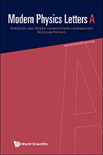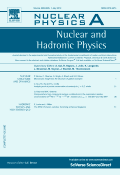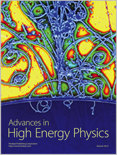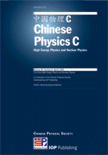
PHYSICS OF PARTICLES AND NUCLEI
metrics 2024
Unveiling the Secrets of the Subatomic World
Introduction
Physics of Particles and Nuclei is an esteemed journal within the field of nuclear and high energy physics, published by Pleiades Publishing Inc. Based in the United States, this journal has been a vital platform for disseminating cutting-edge research since its inception in 1996, with coverage extending until 2024. Indexed under the ISSN 1063-7796 and the E-ISSN 1531-8559, it has established itself as a noteworthy publication, currently categorized in the Q3 quartile according to the 2023 standards for Nuclear and High Energy Physics. With its Scopus ranking placing it at #62 out of 87 in its category, Physics of Particles and Nuclei provides unique insights and discussions that resonate with academics, researchers, and students alike. Although it does not offer open access, the journal continues to serve as a crucial resource for those looking to engage deeply with the latest advancements and theoretical explorations in particle and nuclear physics.
Metrics 2024
 0.26
0.26 0.60
0.60 0.50
0.50 42
42Metrics History
Rank 2024
Scopus
IF (Web Of Science)
JCI (Web Of Science)
Quartile History
Similar Journals

Radiation Detection Technology and Methods
Transforming Nuclear Science Through Innovative ResearchRadiation Detection Technology and Methods is a prominent academic journal published by Springer Singapore Pte Ltd, dedicated to advancing the field of nuclear and high-energy physics, as well as nuclear energy and engineering. Established in 2017, this journal provides a platform for the dissemination of pioneering research and innovative methodologies in radiation detection technology. As of 2023, it holds a commendable Q2 ranking in both the categories of Nuclear and High Energy Physics and Nuclear Energy and Engineering, underscoring its significance in fostering scholarly discourse within these vital fields. With ISSN 2509-9930 and E-ISSN 2509-9949, the journal aims to cater to a diverse audience of researchers, professionals, and students, emphasizing open access to knowledge. The journal's contributions are particularly crucial for those engaged in the development of safer and more efficient radiation detection techniques, ultimately bridging the gap between theory and practical applications in energy security and health physics. For researchers seeking a dedicated outlet for their work, Radiation Detection Technology and Methods represents an invaluable resource and an opportunity to influence the future of radiation science.

MODERN PHYSICS LETTERS A
Pioneering Discoveries in Modern PhysicsMODERN PHYSICS LETTERS A, published by World Scientific Publishing Co Pte Ltd, is a distinguished journal in the field of physics that serves as a pivotal platform for researchers, professionals, and students alike. With ISSN 0217-7323 and E-ISSN 1793-6632, the journal has gained international acclaim for its contributions to Astronomy and Astrophysics as well as Nuclear and High Energy Physics. The journal is ranked in Q3 for both Astronomy and Astrophysics and Nuclear and High Energy Physics, showcasing its relevance in these areas, while also achieving a Q2 ranking in the broader category of Physics and Astronomy (miscellaneous). Spanning from 1996 to 2024, MODERN PHYSICS LETTERS A promotes open dialogue and dissemination of pioneering research findings and innovative theories. While the journal operates without an open access option, its rich content is easily accessible through various academic databases, ensuring that vital research is shared widely among the scientific community. Situated in Singapore, this journal plays an essential role in the continuous advancement of the physics discipline, fostering collaboration and knowledge sharing among global researchers.

Moscow University Physics Bulletin
Advancing Knowledge Through Innovative ResearchMoscow University Physics Bulletin is a distinguished journal published by PLEIADES PUBLISHING INC, focusing on a broad spectrum of topics within the field of physics and astronomy. Since its inception, the journal has championed the dissemination of innovative research and advancements, making significant contributions to the academic community. Although currently categorized in the Q4 quartile and ranked #208/243 in the general physics and astronomy field by Scopus, it provides a valuable platform for emerging ideas and discussions in the sector. The journal's publication span, encompassing crucial years from 1975 to 1977, 1982 to 1989, and 2009 to 2024, showcases its resilience and commitment to advancing knowledge. While the journal follows a traditional access model, its content remains pivotal for researchers, professionals, and students aiming to stay abreast of the latest developments in physics. With contributions reflecting both theoretical advancements and practical applications, Moscow University Physics Bulletin is an essential resource for anyone looking to deepen their understanding of contemporary physics.

EUROPEAN PHYSICAL JOURNAL A
Catalyzing Advances in High Energy Physics ResearchEUROPEAN PHYSICAL JOURNAL A (EPJ A), published by Springer, is a premier journal in the field of Nuclear and High Energy Physics, dedicated to fostering innovative research and scholarly communication within the scientific community. With an impressive impact factor that reflects its significant contribution to the discipline, EPJ A ranks in the Q1 category and boasts a Scopus rank of 24 out of 87, placing it in the 72nd percentile of its field for 2023. This journal, with its ISSN 1434-6001 and E-ISSN 1434-601X, embraces a commitment to open access, ensuring that cutting-edge research is accessible to a global audience. With coverage from 1998 to 2024, EPJ A continues to be a vital resource for researchers, professionals, and students alike, promoting collaboration, knowledge sharing, and advancements in the vast landscape of nuclear physics and high-energy interactions. Located in Germany with a representative address in New York City, this journal serves as a bridge for international scientific discourse.

NUCLEAR PHYSICS A
Advancing the Frontiers of Nuclear DiscoveryNUCLEAR PHYSICS A, published by Elsevier, is a leading international journal dedicated to the fields of Nuclear and High Energy Physics. With an ISSN of 0375-9474 and E-ISSN 1873-1554, the journal has been pivotal in advancing research since its inception in 1967 and is set to continue influencing the discipline through 2025. It holds a commendable Q2 classification in the 2023 category of Nuclear and High Energy Physics, ranking 32nd out of 87 journals in its field according to Scopus, placing it in the 63rd percentile. NUCLEAR PHYSICS A provides valuable insights and disseminates cutting-edge research, aiding researchers, professionals, and students in their academic and practical pursuits. Though it does not currently offer open access, the journal remains a vital resource for those engaged in the exploration of nuclear phenomena and theoretical advancements in high-energy physics.

Advances in High Energy Physics
Unveiling the Universe: Your Gateway to High Energy DiscoveriesAdvances in High Energy Physics, published by HINDAWI LTD, is a premier open-access journal dedicated to the progressive field of Nuclear and High Energy Physics. With an ISSN of 1687-7357 and an E-ISSN of 1687-7365, this journal has been at the forefront of scientific discourse in high energy physics since its inception in 2007. The journal is notable for its impact within the community, currently holding a Q2 ranking in 2023 and positioned at #36 out of 87 in its category according to Scopus, highlighting its significant contribution to ongoing research and advancement in the field. Its accessible nature enables researchers, professionals, and students to engage with cutting-edge findings that shape our understanding of the universe. Spanning publications from 2010 through 2024, Advances in High Energy Physics serves as an invaluable resource for those looking to stay informed about the latest developments and methodologies in high energy physics across the globe.

Chinese Physics C
Pioneering Research for Tomorrow's DiscoveriesChinese Physics C is a premier, peer-reviewed journal published by IOP Publishing Ltd, dedicated to advancing knowledge in the fields of Astronomy and Astrophysics, Instrumentation, and Nuclear and High Energy Physics. With an impressive impact factor reflecting its standing in the Q1 quartile across multiple categories, this journal serves as a vital resource for researchers, professionals, and students seeking to engage with cutting-edge developments and experimental findings. Since its inception in 2008, Chinese Physics C has fostered significant collaborations and discussions within the global physics community, enabling easy access to high-quality research through its open access options. Operating from the United Kingdom with a commitment to excellence, this journal not only showcases high-impact papers but also encourages innovative methodologies and interdisciplinary approaches, solidifying its role as an essential platform for dissemination and dialogue in the rapidly evolving landscape of physics.

PHYSICAL REVIEW LETTERS
Highlighting the Essence of Physics InnovationPhysical Review Letters, published by the American Physical Society, is a premier journal in the field of Physics and Astronomy renowned for its rapid dissemination of high-impact research findings. With a distinguished history dating back to 1958 and an impressive ranking of #13 out of 243 in the general physics category, it stands proudly within the Q1 quartile, placing it in the top 6% of journals in its field. The journal focuses on brief reports of significant fundamental research across all areas of physics, making it an essential resource for researchers, professionals, and students seeking to stay at the forefront of developments in their field. Although Physical Review Letters does not offer open access options, its rigorous peer-review process ensures a high standard of quality and relevance in its published articles. With an unwavering commitment to advancing the understanding of physical science, this journal is indispensable for those looking to make a genuine impact in their research endeavors.

EUROPEAN PHYSICAL JOURNAL C
Exploring the Depths of Quantum Field TheoryEUROPEAN PHYSICAL JOURNAL C (EPJ C), published by SPRINGER, stands as a premier platform for innovative research in the domains of Physics and Engineering. With its Open Access policy established in 2014, EPJ C ensures that groundbreaking findings are readily available to the global scientific community, enhancing accessibility and collaboration. The journal, indexed in prestigious databases, boasts an impressive impact factor and ranks within the Q1 category for both Engineering and Physics and Astronomy, placing it among the top-tier journals in these fields. Celebrated for its rigorous peer-review process, EPJ C offers a wide-ranging scope encompassing various topics in particle physics, quantum field theory, and related interdisciplinary studies. Its consistent publication since 1991 has fostered a vibrant community of researchers dedicated to advancing knowledge and innovation in physics and engineering. Join the scholarly discussion and contribute to the cutting-edge research made possible through EPJ C's esteemed platform.

Atoms
Connecting researchers with groundbreaking atomic discoveries.Atoms is a distinguished open-access journal published by MDPI since 2013, dedicated to the fields of Atomic and Molecular Physics, Condensed Matter Physics, and Nuclear and High Energy Physics. With its E-ISSN of 2218-2004, the journal is based in Switzerland and has rapidly established itself as a noteworthy platform for disseminating innovative research and developments in atomic-scale physics. As reflected in its 2023 Scopus ranking, Atoms holds a respectable position within its field, with quartile rankings in the third tier across all its main categories. The journal's commitment to open access fosters a broader reach and collaboration within the scientific community, making it an essential resource for researchers, professionals, and students alike. The ongoing convergence of trends and research from 2013 to 2024 highlights Atoms' role in advancing knowledge and facilitating dialogue in crucial areas of physics.